
您正在查看 KubeSphere 版本的文档:v3.0.0
KubeSphere v3.0.0 版本的文档已不再维护。您现在看到的版本来自于一份静态的快照。如需查阅最新文档,请点击 最新版本。
在 VMware vSphere 安装 KubeSphere
对于生产环境,我们需要考虑集群的高可用性。如果关键组件(例如 kube-apiserver,kube-scheduler 和 kube-controller-manager)都在同一主节点上运行,一旦主节点出现故障,Kubernetes 和 KubeSphere 将不可用。因此,我们需要通过用负载均衡器配置多个主节点来设置高可用性集群。您可以使用任何云负载平衡器或任何硬件负载平衡器(例如F5)。另外,Keepalived 和 HAproxy 或 NGINX 也是创建高可用性集群的替代方法。
本教程介绍如何使用 Keepalived + HAProxy 对 kube-apiserver 进行负载均衡,实现高可用 Kubernetes 集群。
前提条件
- 参考多节点安装指南,确保您已经知道如何安装多节点 KubeSphere 集群。本教程重点介绍如何配置负载均衡器实现高可用。
- 您需要一个 VMware vSphere 帐户来创建 VM 资源。
- 考虑到数据的持久性,对于生产环境,我们建议您准备持久化存储。若搭建开发和测试环境,可以直接使用默认集成的 OpenEBS 的 LocalPV。
部署架构
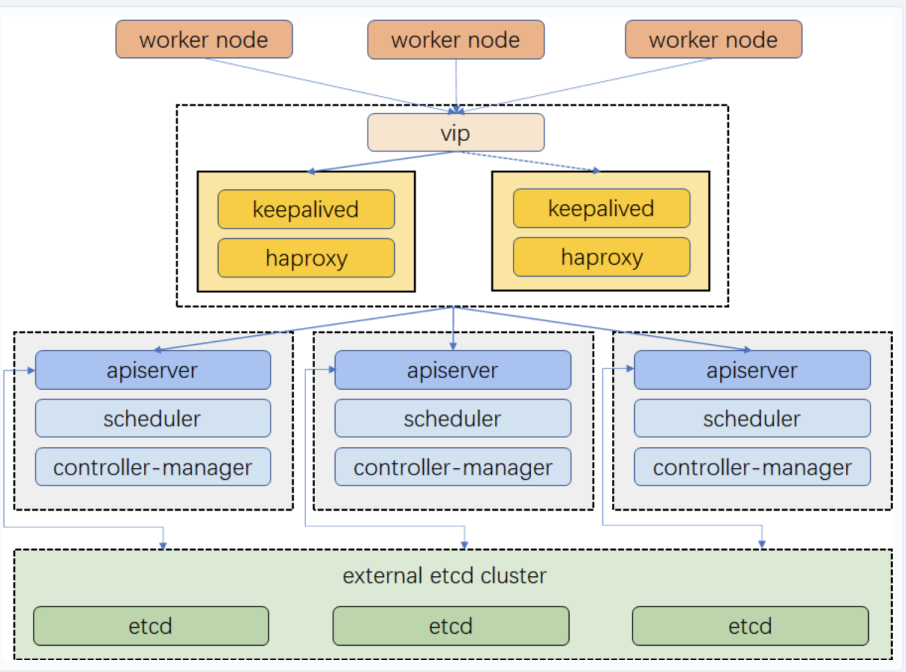
创建主机
本示例创建 8 台 CentOS Linux release 7.6.1810(Core) 的虚拟机部署默认的最小化安装,每台配置为 2 Core,4 GB,40 G 即可。
| 主机 IP | 主机名称 | 角色 |
|---|---|---|
| 10.10.71.214 | master1 | master, etcd |
| 10.10.71.73 | master2 | master, etcd |
| 10.10.71.62 | master3 | master, etcd |
| 10.10.71.75 | node1 | worker |
| 10.10.71.76 | node2 | worker |
| 10.10.71.79 | node3 | worker |
| 10.10.71.67 | vip | 虚拟 IP(不是实际的主机) |
| 10.10.71.77 | lb-0 | lb(Keepalived + HAProxy |
| 10.10.71.66 | lb-1 | lb(Keepalived + HAProxy |
备注
-
选择可创建的资源池,点击右键,选择新建虚拟机(创建虚拟机入口有好几个,请自己选择)
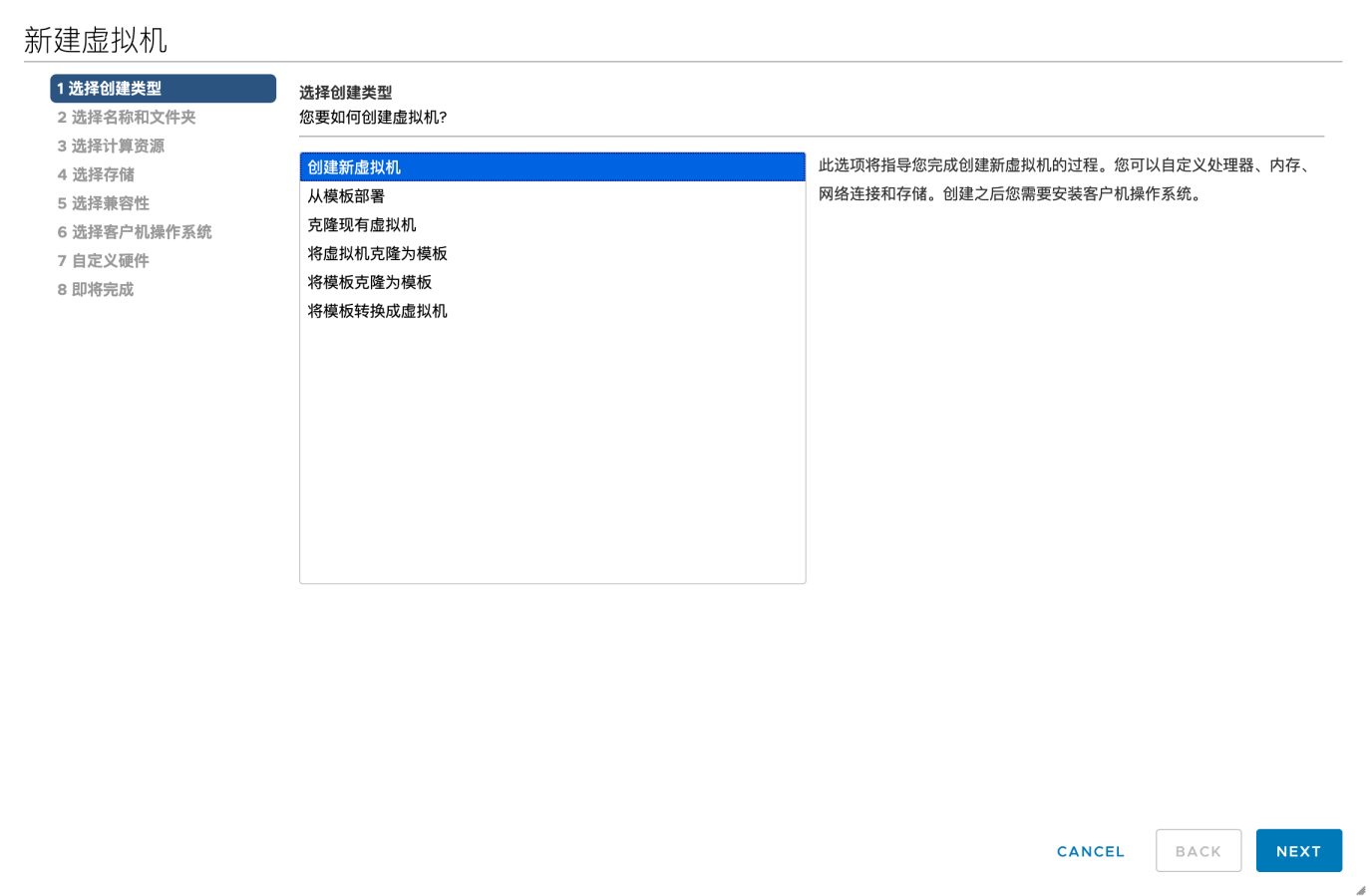
-
选择创建类型,创建新虚拟机。
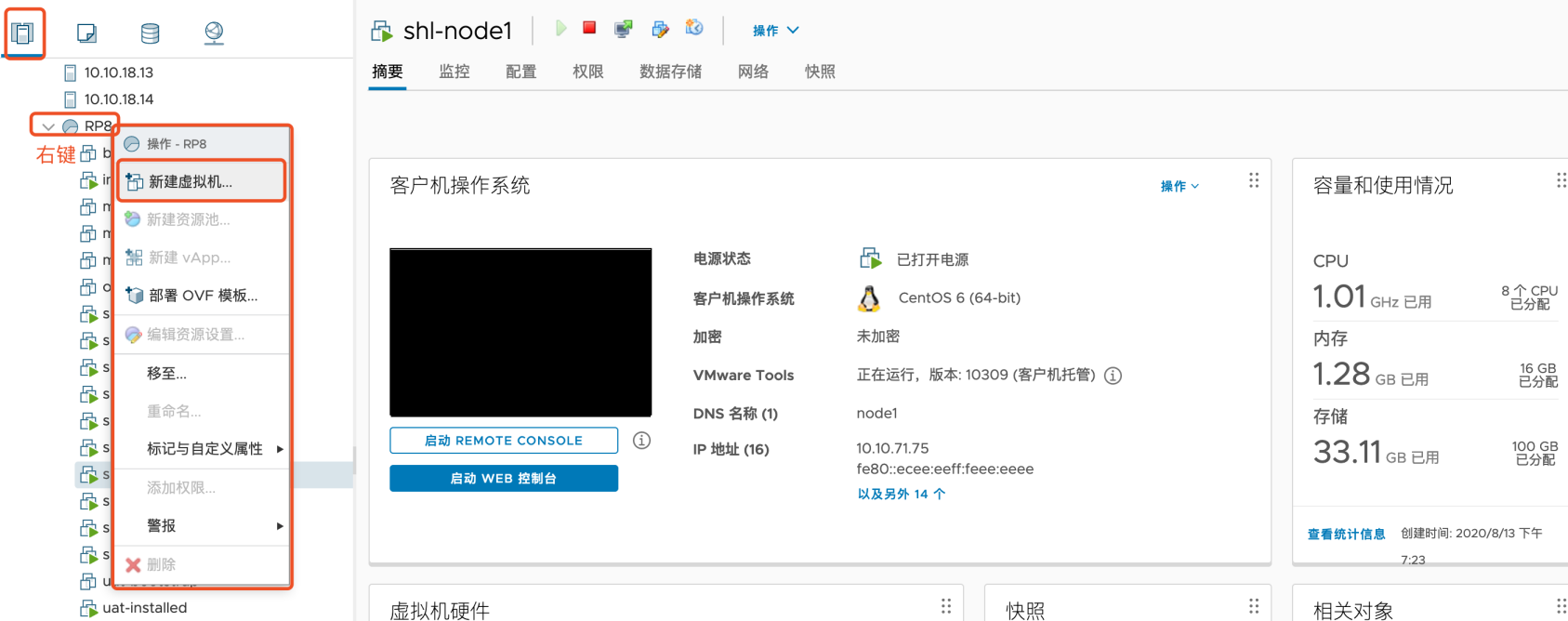
-
填写虚拟机名称和存放文件夹。
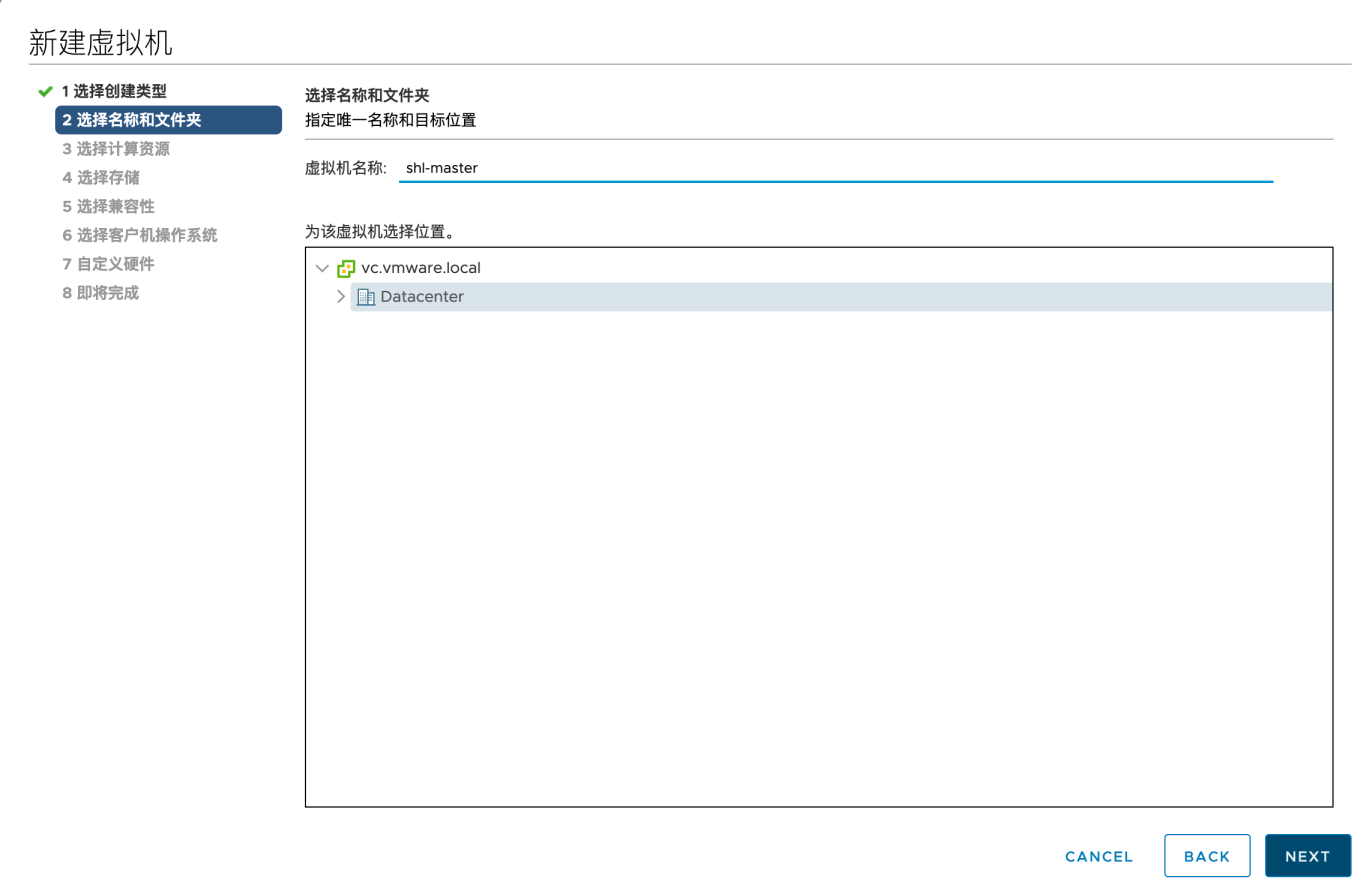
-
选择计算资源。
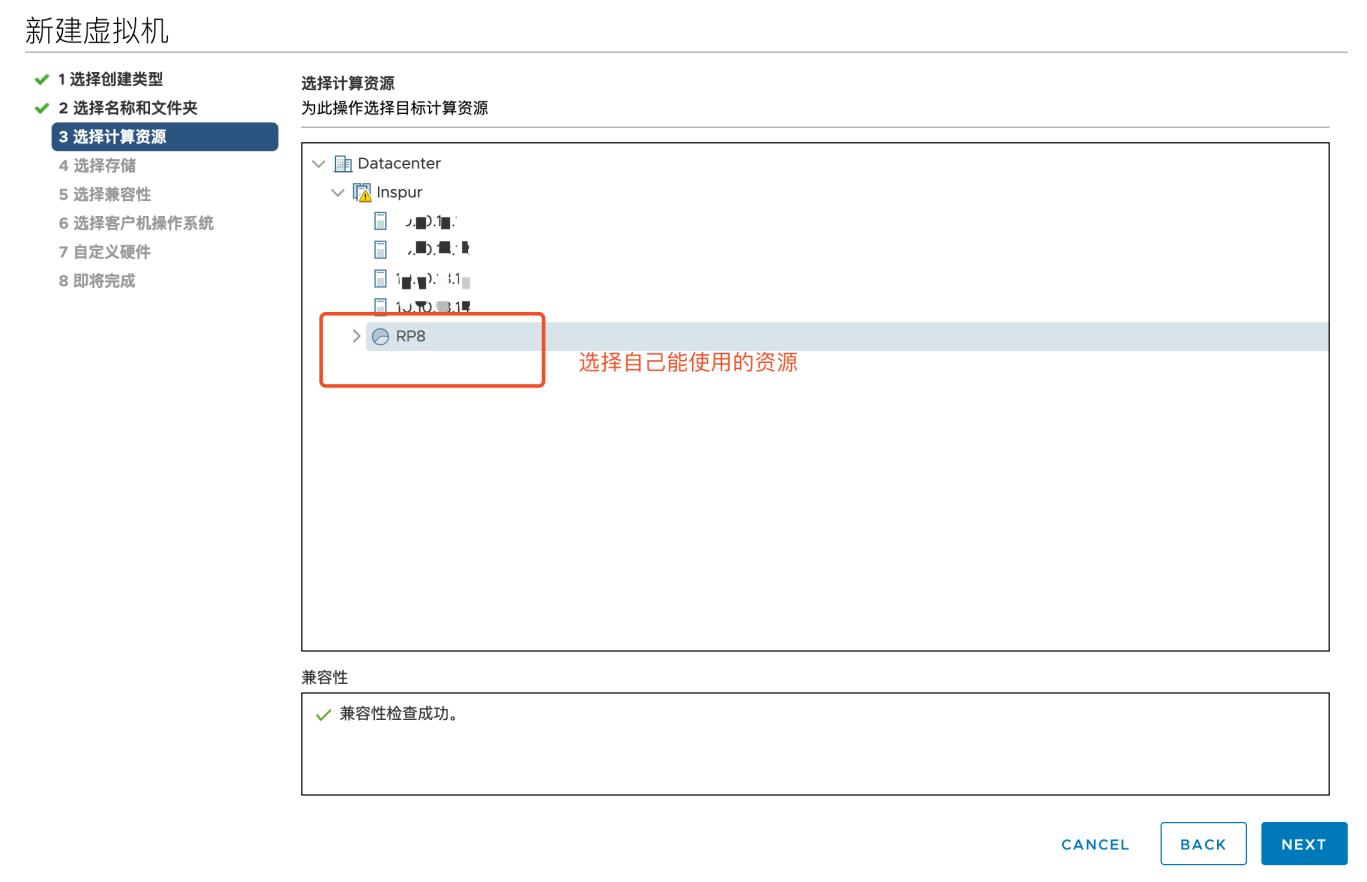
-
选择存储。
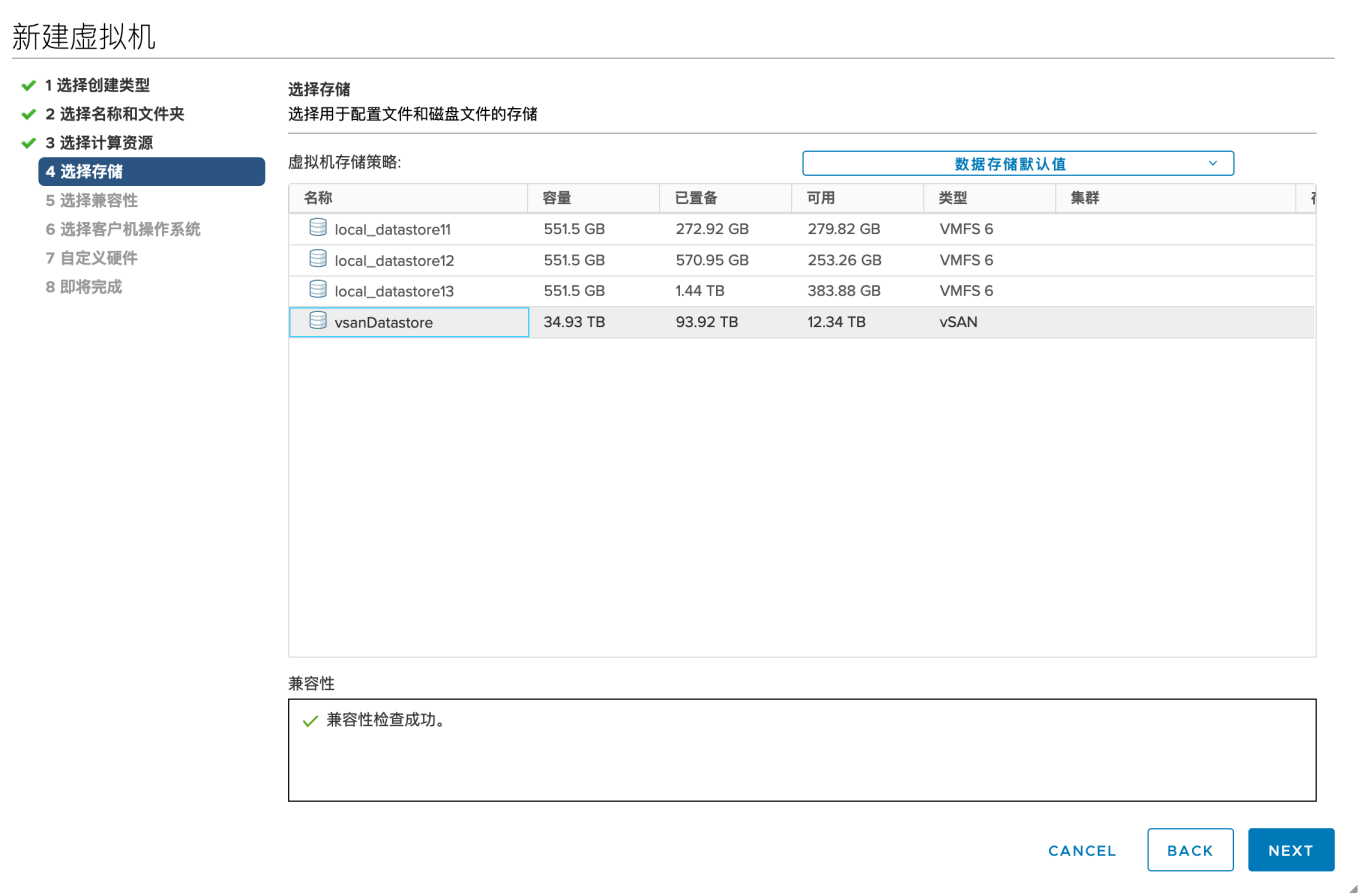
-
选择兼容性,这里是 ESXi 7.0 及更高版本。

-
选择客户机操作系统,Linux CentOS 7 (64 位)。

-
自定义硬件,这里操作系统是挂载的 ISO 文件(打开电源时连接),网络是 VLAN71(勾选)。
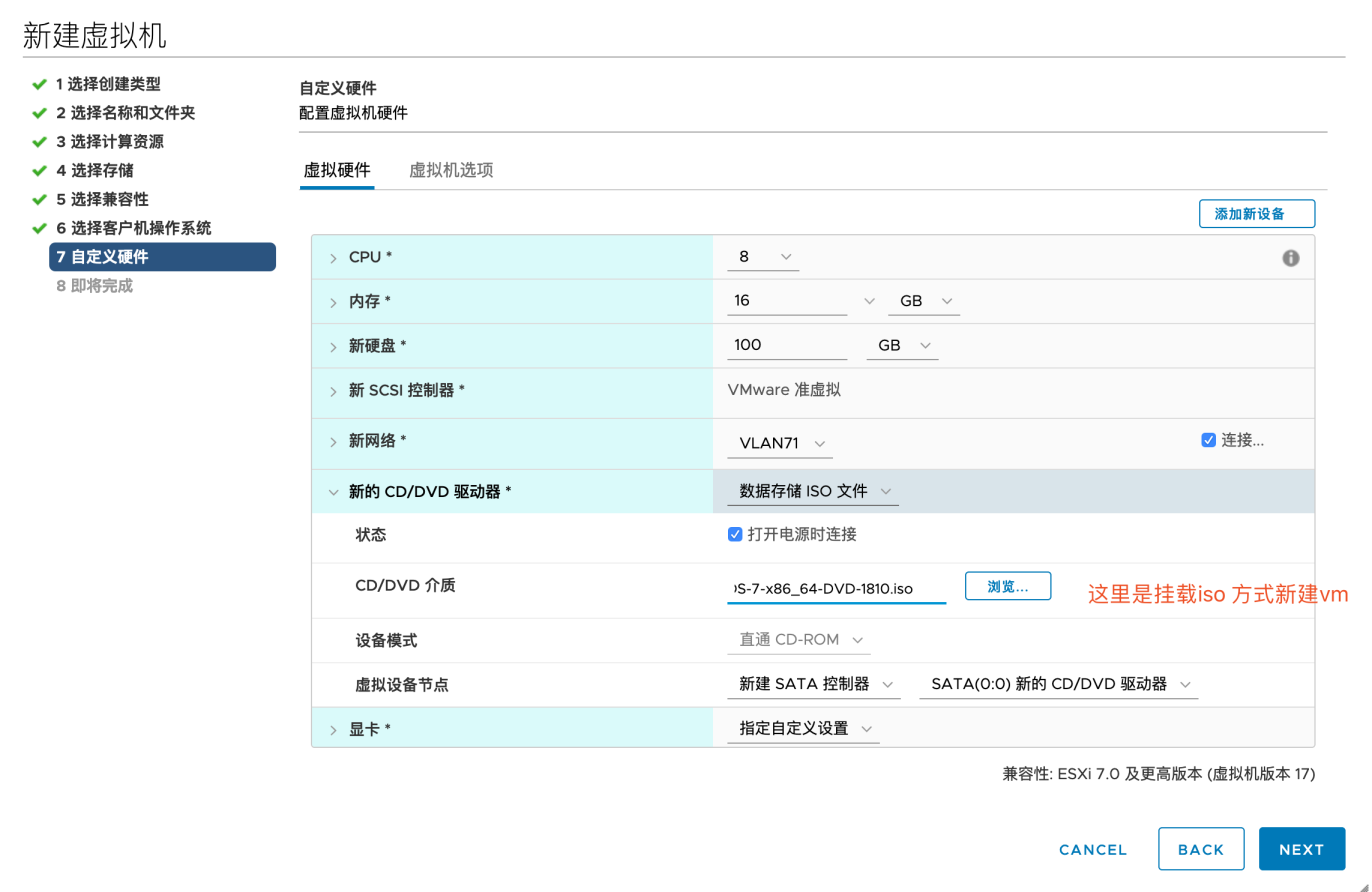
-
在即将完成页面上可查看为虚拟机选择的配置。
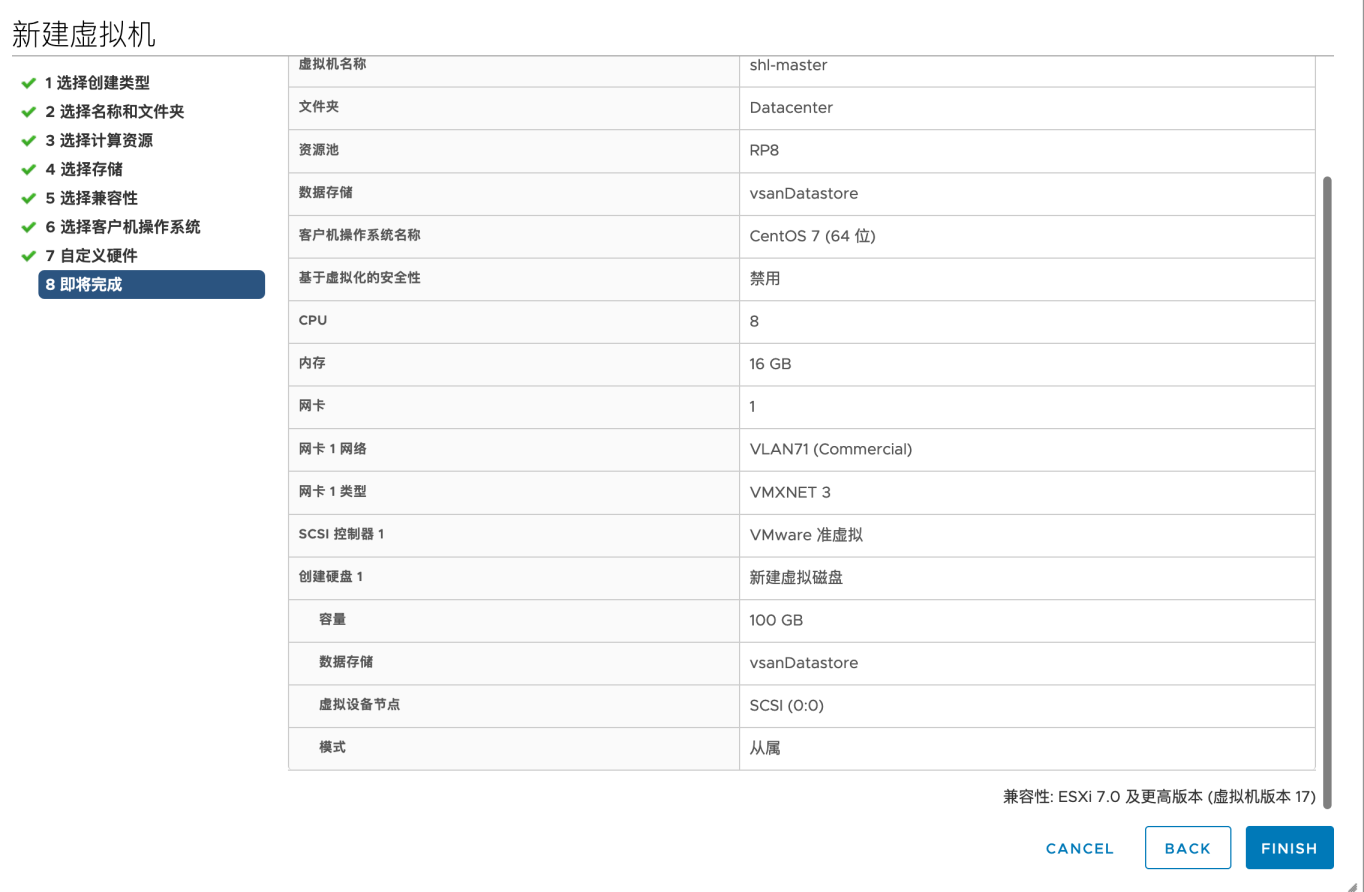
部署 keepalived 和 HAproxy
生产环境需要单独准备负载均衡器,例如 NGINX、F5、Keepalived + HAproxy 这样的私有化部署负载均衡器方案。如果您是准备搭建开发或测试环境,无需准备负载均衡器,可以跳过此小节。
Yum 安装
在主机为 lb-0 和 lb-1 中部署 Keepalived + HAProxy 即 IP 为10.10.71.77与10.10.71.66的服务器上安装部署 HAProxy 和 psmisc。
yum install keepalived haproxy psmisc -y
配置 HAProxy
在 IP 为10.10.71.77与10.10.71.66的服务器上按如下参数配置 HAProxy (两台 lb 机器配置一致即可,注意后端服务地址)。
# HAProxy Configure /etc/haproxy/haproxy.cfg
global
log 127.0.0.1 local2
chroot /var/lib/haproxy
pidfile /var/run/haproxy.pid
maxconn 4000
user haproxy
group haproxy
daemon
# turn on stats unix socket
stats socket /var/lib/haproxy/stats
#---------------------------------------------------------------------
# common defaults that all the 'listen' and 'backend' sections will
# use if not designated in their block
#---------------------------------------------------------------------
defaults
log global
option httplog
option dontlognull
timeout connect 5000
timeout client 5000
timeout server 5000
#---------------------------------------------------------------------
# main frontend which proxys to the backends
#---------------------------------------------------------------------
frontend kube-apiserver
bind *:6443
mode tcp
option tcplog
default_backend kube-apiserver
#---------------------------------------------------------------------
# round robin balancing between the various backends
#---------------------------------------------------------------------
backend kube-apiserver
mode tcp
option tcplog
balance roundrobin
default-server inter 10s downinter 5s rise 2 fall 2 slowstart 60s maxconn 250 maxqueue 256 weight 100
server kube-apiserver-1 10.10.71.214:6443 check
server kube-apiserver-2 10.10.71.73:6443 check
server kube-apiserver-3 10.10.71.62:6443 check
启动之前检查语法是否有问题
haproxy -f /etc/haproxy/haproxy.cfg -c
启动 Haproxy,并设置开机自启动
systemctl restart haproxy && systemctl enable haproxy
停止 Haproxy
systemctl stop haproxy
配置 Keepalived
主 HAProxy 77 lb-0-10.10.71.77 (/etc/keepalived/keepalived.conf)
global_defs {
notification_email {
}
smtp_connect_timeout 30 #连接超时时间
router_id LVS_DEVEL01 ##相当于给这个服务器起个昵称
vrrp_skip_check_adv_addr
vrrp_garp_interval 0
vrrp_gna_interval 0
}
vrrp_script chk_haproxy {
script "killall -0 haproxy"
interval 2
weight 20
}
vrrp_instance haproxy-vip {
state MASTER #主服务器 是MASTER
priority 100 #主服务器优先级要比备服务器高
interface ens192 #实例绑定的网卡
virtual_router_id 60 #定义一个热备组,可以认为这是60号热备组
advert_int 1 #1秒互相通告一次,检查对方死了没。
authentication {
auth_type PASS #认证类型
auth_pass 1111 #认证密码 这些相当于暗号
}
unicast_src_ip 10.10.71.77 #当前机器地址
unicast_peer {
10.10.71.66 #peer中其它机器地址
}
virtual_ipaddress {
#vip地址
10.10.71.67/24
}
track_script {
chk_haproxy
}
}
备 HAProxy 66 lb-1-10.10.71.66 (/etc/keepalived/keepalived.conf)
global_defs {
notification_email {
}
router_id LVS_DEVEL02 ##相当于给这个服务器起个昵称
vrrp_skip_check_adv_addr
vrrp_garp_interval 0
vrrp_gna_interval 0
}
vrrp_script chk_haproxy {
script "killall -0 haproxy"
interval 2
weight 20
}
vrrp_instance haproxy-vip {
state BACKUP #备份服务器 是 backup
priority 90 #优先级要低(把备份的90修改为100)
interface ens192 #实例绑定的网卡
virtual_router_id 60
advert_int 1
authentication {
auth_type PASS
auth_pass 1111
}
unicast_src_ip 10.10.71.66 #当前机器地址
unicast_peer {
10.10.71.77 #peer 中其它机器地址
}
virtual_ipaddress {
#加/24
10.10.71.67/24
}
track_script {
chk_haproxy
}
}
启动 keepalived,设置开机自启动
systemctl restart keepalived && systemctl enable keepalived
systemctl stop keepaliv
开启 keepalived服务
systemctl start keepalivedb
验证可用性
使用ip a s查看各 lb 节点 vip 绑定情况
ip a s
暂停 vip 所在节点 HAProxy
systemctl stop haproxy
再次使用ip a s查看各 lb 节点 vip 绑定情况,查看 vip 是否发生漂移
ip a s
或者使用下面命令查看
systemctl status -l keepalived
下载 KubeKey 安装程序
下载可执行安装程序 kk 至一台目标机器:
从 GitHub Release Page 下载 KubeKey 或直接使用以下命令。
curl -sfL https://get-kk.kubesphere.io | VERSION=v1.0.1 sh -
先执行以下命令以确保您从正确的区域下载 KubeKey。
export KKZONE=cn
执行以下命令下载 KubeKey。
curl -sfL https://get-kk.kubesphere.io | VERSION=v1.0.1 sh -
备注
export KKZONE=cn 命令。备注
为 kk 添加可执行权限:
chmod +x kk
创建多节点集群
您可以使用高级安装来控制自定义参数或创建多节点集群。具体来说,通过指定配置文件来创建集群。
KubeKey 部署集群
创建配置文件(一个示例配置文件)。
./kk create config --with-kubesphere v3.0.0 --with-kubernetes v1.17.9
备注
-
经过充分测试的 Kubernetes 版本有:v1.15.12,v1.16.13,v1.17.9(默认),v1.18.6,您可以根据需要指定版本。
-
如果您在这一步的命令中不添加标志
--with-kubesphere,则不会部署 KubeSphere,只能使用配置文件中的addons字段安装,或者在您后续使用./kk create cluster命令时再次添加这个标志。 -
如果您添加标志
--with-kubesphere时不指定 KubeSphere 版本,则会安装最新版本的 KubeSphere。
默认文件 config-sample.yaml 创建后,根据您的环境修改该文件。
vi ~/config-sample.yaml
apiVersion: kubekey.kubesphere.io/v1alpha1
kind: Cluster
metadata:
name: config-sample
spec:
hosts:
- {name: master1, address: 10.10.71.214, internalAddress: 10.10.71.214, password: P@ssw0rd!}
- {name: master2, address: 10.10.71.73, internalAddress: 10.10.71.73, password: P@ssw0rd!}
- {name: master3, address: 10.10.71.62, internalAddress: 10.10.71.62, password: P@ssw0rd!}
- {name: node1, address: 10.10.71.75, internalAddress: 10.10.71.75, password: P@ssw0rd!}
- {name: node2, address: 10.10.71.76, internalAddress: 10.10.71.76, password: P@ssw0rd!}
- {name: node3, address: 10.10.71.79, internalAddress: 10.10.71.79, password: P@ssw0rd!}
roleGroups:
etcd:
- master1
- master2
- master3
master:
- master1
- master2
- master3
worker:
- node1
- node2
- node3
controlPlaneEndpoint:
domain: lb.kubesphere.local
# vip
address: "10.10.71.67"
port: "6443"
kubernetes:
version: v1.17.9
imageRepo: kubesphere
clusterName: cluster.local
masqueradeAll: false # masqueradeAll tells kube-proxy to SNAT everything if using the pure iptables proxy mode. [Default: false]
maxPods: 110 # maxPods is the number of pods that can run on this Kubelet. [Default: 110]
nodeCidrMaskSize: 24 # internal network node size allocation. This is the size allocated to each node on your network. [Default: 24]
proxyMode: ipvs # mode specifies which proxy mode to use. [Default: ipvs]
network:
plugin: calico
calico:
ipipMode: Always # IPIP Mode to use for the IPv4 POOL created at start up. If set to a value other than Never, vxlanMode should be set to "Never". [Always | CrossSubnet | Never] [Default: Always]
vxlanMode: Never # VXLAN Mode to use for the IPv4 POOL created at start up. If set to a value other than Never, ipipMode should be set to "Never". [Always | CrossSubnet | Never] [Default: Never]
vethMTU: 1440 # The maximum transmission unit (MTU) setting determines the largest packet size that can be transmitted through your network. [Default: 1440]
kubePodsCIDR: 10.233.64.0/18
kubeServiceCIDR: 10.233.0.0/18
registry:
registryMirrors: []
insecureRegistries: []
addons: []
···
# 其它配置可以在安装后之后根据需要进行修改
持久化存储配置
如本文开头的前提条件所说,对于生产环境,我们建议您准备持久性存储,可参考以下说明进行配置。若搭建开发和测试环境,您可以跳过这小节,直接使用默认集成的 OpenEBS 的 LocalPV 存储。
继续编辑上述config-sample.yaml文件,找到[addons]字段,这里支持定义任何持久化存储的插件或客户端,如 NFS Client、Ceph、GlusterFS、CSI,根据您自己的持久化存储服务类型,并参考 持久化存储服务 中对应的示例 yaml 文件进行设置。
执行创建集群
使用上面自定义的配置文件创建集群:
./kk create cluster -f config-sample.yaml
根据表格的系统依赖的前提条件检查,如果相关依赖都显示 √,则可以输入 yes 继续执行安装。
验证安装结果
此时可以看到安装日志自动输出,或者可以再打开一个 SSH 手动检查安装日志,然后等待安装成功。
kubectl logs -n kubesphere-system $(kubectl get pod -n kubesphere-system -l app=ks-install -o jsonpath='{.items[0].metadata.name}') -f
如果最后返回Welcome to KubeSphere,则表示已安装成功。
**************************************************
#####################################################
### Welcome to KubeSphere! ###
#####################################################
Console: http://10.10.71.214:30880
Account: admin
Password: P@88w0rd
NOTES:
1. After logging into the console, please check the
monitoring status of service components in
the "Cluster Management". If any service is not
ready, please wait patiently until all components
are ready.
2. Please modify the default password after login.
#####################################################
https://kubesphere.io 2020-08-15 23:32:12
#####################################################
登录 console 界面
使用上述日志中给定的访问地址进行访问,进入到 KubeSphere 的登陆界面并使用默认账号(用户名admin,密码P@88w0rd)即可登陆平台。


开启可插拔功能组件(可选)
上面的示例演示了默认的最小安装过程,对于可插拔组件,可以在安装之前或之后启用它们。有关详细信息,请参见启用可插拔组件。













 上一篇
上一篇
